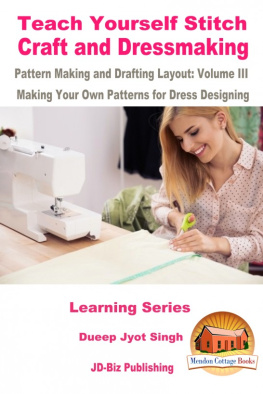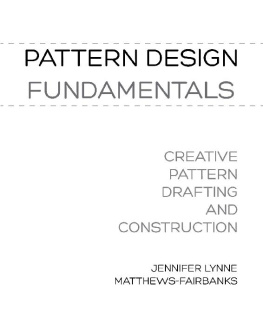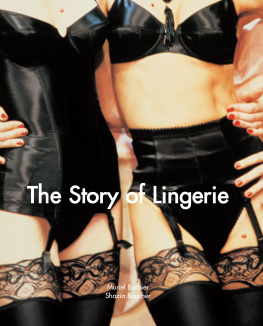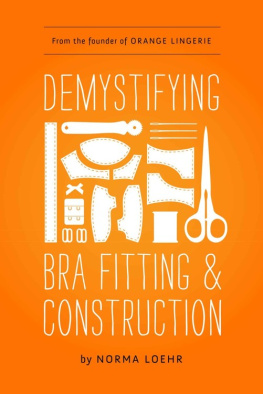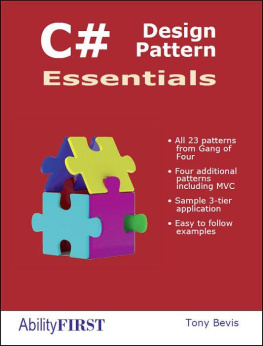Bare Essentials: Bras
Construction and Pattern Draftingfor Lingerie Design
Written by Jennifer LynneMatthews-Fairbanks
Copyright 2012
Publication by Los Angeles FashionResource, a subsidiary of Fairbanks Publishing, LLC
All rights reserved. No part of thisbook may be reproduced electronically or by other means without permission inwriting from the author, except by a reviewer who wishes to quote passages inconnection with a review written for inclusion in a magazine, newspaper ordigital press medium.
The patterns from this book can be downloaded at www.lafashionresource.com.
Printed ISBN-10: 0983132844
Printed ISBN-13: 978-0-9831328-4-4
Table of Contents
Beginner
Intermediate
Advanced
Preface
As a lingerie designer and educator, I felt there was a hole in educational texts for lingerie design. I compiled this information for educational purposes from personal experience and experimentation. This book series is designed to take an individual through the process of sewing lingerie, developing pattern modifications and drafting from measurements.
This book covers many different aspects of the design process and is divided into three basic sections As one progresses through the book, the directions become more complex, as to help each individual master the art of lingerie design.
Each step in the book has been tested by both students and educators to achieve the best possible information possible. If you encounter a discrepancy, please contact us so we will be able to update the book with the correct information. If you are unable to achieve our results, feel free to contact us regarding the issue. It may be a mistake on our part, or possibly we could help explain it more thoroughly. Feedback is always welcome and I thoroughly encourage it.
This book is volume two of the Bare Essentials series. The focus of this book is bra design. Check www.losangelesfashionresource.com periodically for updates on new books available from the series. Currently three additional volumes are planned, including active wear, lounge wear and mens undergarments. The first book in the series focuses on underwear design.
Enjoy your venture into designing and creating your own lingerie.
-Jennifer Matthews-Fairbanks
Jennifer Lynne Matthews-Fairbanks is an instructor at the FashionInstitute of Design and Merchandising in Los Angeles. She ownsand operates her own lingerie design business, Porcelynne Lingerie, which hasbeen in operation for the past 10 years.
A special thanks to my husband, David Fairbanks, for being there for me every step of the way. I would also like to thank Katie Sabo and my special projects class at FIDM for their help in the completion of this book.
Chapter 1
Introduction to LingerieConstruction
Before entering a path into bra design, one should develop an understanding of bra construction and the materials used.
Each introduction chapter details the tools, supplies, notions and materials used for the projects in that section.
Anatomy of a Bra
There are three general parts to a bra: the cup, the band and the bridge.
Cup - A cup of a bra can be seamed or molded, with a variety of coverages: full coverage, demi cup, half cup or quarter cup. The high point of the cup is referred to as the apex or bust point.
A seamed cup contains one or more seams to shape the bust and is generally in a stable fabric without stretch. This seam can be horizontal, vertical, diagonal or any design of your choosing. The key is that one seam intersects the apex of the bust.
All seams on a bra should be shielded from the body from irritation by either a lining or the use of seam tape. A seamed cup can also be padded.
A molded cup is another possibility, but as a designer or maker, you are generally limited in this area due to the specifications made by the manufacturer of the specific cup. Molded cups can be with or without padding.
Band - The band can be in multiple pieces, joining under the cup and/or at the side seam.
A band that contains a side seam generally has two distinct differences: the front band contains no stretch (and utilizes a stabilizer) and the back band is constructed of a stretch fabric such aspower netting. Larger cup sizes may contain a piece of boning at the side seam for additional support of the bust.
A band can also be constructed without a side seam. The entire band in this scenario would be constructed of a stretch material. The center bridge would need to be stabilized even if the entire band is constructed out of a knit.
Bridge - This is the center of the bra that connects the two cups together. The bridge can be incorporated into the band, it can be freestanding or it could be decorative in nature by using alternative materials in the construction. The bridge uses a stabilizer to keep from stretching out of shape.

Tools and Supplies
If you are a seasoned sewer, you will most likely already possess many of these tools, but for those just starting out, this is a suggested shopping list.
Dressmaker Pins - There are a variety of different pins one can use in sewing. Some are very pliable and made from less than quality materials, while others are sturdy and strong. In the varieties available, make sure to get pins that are appropriate for what you are working on. Silk pins are recommended for delicate fabrics.
Because I have spilled over a box of pins more than once in my life, I recommend using a magnetic pin cushion over the traditional tomato.
For those of you that might be prone to farsightedness, you may wish to use pins with colored plastic on the end. Just be careful, you cannot iron over the colored balls or they will surely melt to whatever you are working on and ruin your iron.
Dot Paper - Dot paper is what we use in the industry for drafting. Although funny enough, the markings are generally not dots, but numbers and letters on a grid. Dot paper can also be referred to as alpha-numeric paper. This paper may not be available in all areas. Poster paper or craft paper can be used as acceptable alternatives. I prefer white poster paper for its moderate transparency.
Fabric Shears and Scissors - The words shears and scissors can be interchanged, although shears is the industry standard term. Make sure to purchase a pair of quality shears and designate them for fabric use only. A good pair can cost a pretty penny, so make sure not to cut paper, hair or random household items with these scissors.
French curve - A French curve is used for making small and tight curved shapes, generally for armholes and necklines, but it can be used for other shapes as well. French curves are sometimes available in a variety pack containing multiple curved shapes.

Hip or Vary Curve - A hip curve or vary curve will be needed for longer and gradual curves, typically used for waistlines and side seams.
Paper Scissors - As one should have a pair of scissors specific to fabric, a pair specifically for cutting paper products is also necessary.
Pencils - In order to get accurate shapes and edges, either use a mechanical pencil or a pencil with a very sharp point (or have a pencil sharpener handy). You may wish to have a few colored pencils handy to help differentiate pattern changes.


